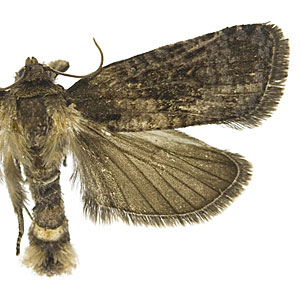Adult Recognition

FWL: 10.0-12.0 mm
Males are pale brown with black and grayish-purple markings that give an overall grayish-brown appearance. Females are uniformly dark grayish brown. Both males and females have a conspicuous light dot on the distal one-third of the forewing; this dot is usually orange in males and whitish in females. Hindwings are brown. Males lack a forewing costal fold.
Male genitalia are characterized by an elongate uncus that is widened above the base and tapered towards the apex, densely setose socii, and subtriangular valvae. Female genitalia are characterized by broad papillae anales and two large signa in the corpus bursae. Males have two large patches of coremata on the posterior margin of segment VIII that are composed of scales of a uniform length.
The subgenus Cryptaspasma contains a total of six species, including C. perseana, all of which are difficult to separate. The only species present in North America north of Mexico is Cryptaspasma bipenicilla, which can be separated from most described Neotropical Cryptaspasma (subgenus Cryptaspasma) by coremata composed of two lengths of scales on the male abdomen.
Larval Morphology

Larvae are orange to pink with a yellowish brown head and prothoracic shield. Pinacula are weakly sclerotized. Diagnostic characters include: D2 setae on A8 on the same "saddle" pinaculum; D1, D2, and SD1 setae on A9 all on the same large "saddle" pinaculum; L pinaculum on A9 bisetose; and anal comb absent.
Biology

The following life history information is for C. perseana reared under laboratory conditions. Females lay eggs in masses of 2-73 individual eggs on smooth surfaces, including avocado fruit and seeds. Eggs hatch in approximately 11 days and larvae bore into avocado seeds. A single avocado seed can support 5-8 individual larvae. Larval damage is characterized by feeding tunnels in seeds, damaged pulp, and accumulation of frass at the opening of feeding tunnels. Larval development is completed in approximately three weeks, and pupation occurs outside of the seed, possibly under bark or in leaf litter.
Host plants
Larvae of Cryptaspasma perseana feed in avocado seeds.
| Family | Genus/species | Common name |
| Lauraceae | Persea americana Mill. | avocado |
Distribution

Cryptaspasma perseana is recorded from Michoacan, Mexico and Central Guatemala.
References

Gilligan, T. M., J. W. Brown and M. S. Hoddle. 2011. A new avocado pest in Central America (Lepidoptera: Tortricidae) with a key to Lepidoptera larvae threatening avocados in California. Zootaxa. 3137: 31-45.

